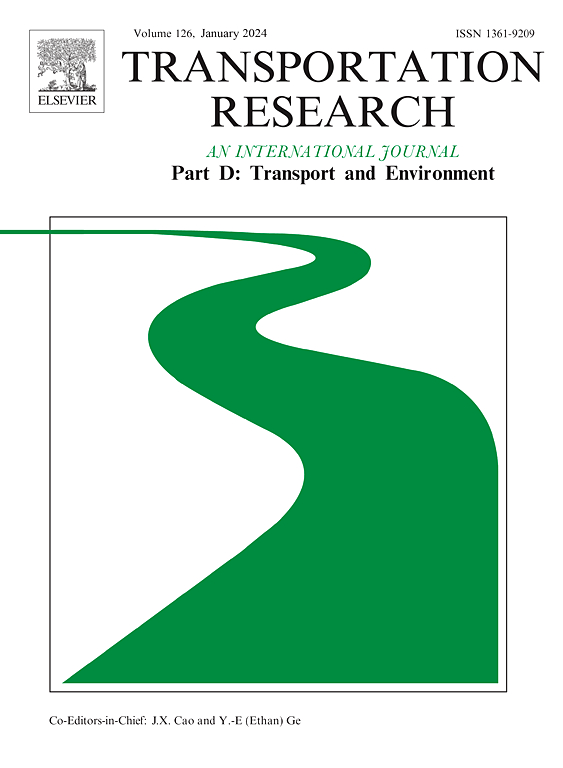基于单智能体和多智能体强化学习的混合交通环境下队列生态合作自适应巡航控制
IF 7.3
1区 工程技术
Q1 ENVIRONMENTAL STUDIES
Transportation Research Part D-transport and Environment
Pub Date : 2025-03-22
DOI:10.1016/j.trd.2025.104658
引用次数: 0
摘要
信号主干道造成走走停停的交通,导致碰撞、延误、能源浪费和不适。使用合作自适应巡航控制(CACC)的互联自动驾驶汽车(cav)可以通过共享信息优化速度,从而潜在地缓解这些问题。然而,信号道路CACC研究中的交通环境主要是通过仿真生成的。本文比较了各种基于强化学习(RL)的生态友好型CACC方法,用于在信号动脉上与人类驾驶车辆(HVs)一起操作的cav。分析方法包括深度确定性策略梯度(DDPG)、软行为者评价(SAC)及其多智能体版本(MADDPG、MASAC),并在来自pNEUMA数据集的自然数据上进行训练和测试。这些强化学习方法是针对混合排场景中人类驱动的轨迹和智能驾驶员模型(IDM)进行基准测试的。结果表明,DDPG和SAC在车辆性能(安全性、效率、能量、舒适性)方面表现较好,而MADDPG和MASAC在排稳定性方面表现较好。影响性能的关键因素包括队列特征、车辆位置和前面的车辆类型。本文章由计算机程序翻译,如有差异,请以英文原文为准。
Eco-cooperative adaptive cruise control for platoons in mixed traffic using single-agent and multi-agent reinforcement learning
Signalized arterials create stop-and-go traffic, leading to collisions, delays, wasted energy, and discomfort. Connected Automated Vehicles (CAVs), using Cooperative Adaptive Cruise Control (CACC), can potentially mitigate these issues by optimizing speeds with shared information. However, the traffic environment in CACC research on signalized roads is predominantly generated through simulations. This paper compares various eco-friendly CACC methods based on reinforcement learning (RL) for CAVs operating with Human-driven Vehicles (HVs) on signalized arterials. Methods analyzed include Deep Deterministic Policy Gradient (DDPG), Soft Actor-Critic (SAC), and their multi-agent versions (MADDPG, MASAC), trained and tested on naturalistic data from the pNEUMA dataset. These RL methods are benchmarked against human-driven trajectories and the Intelligent Driver Model (IDM) in mixed platoon scenarios. Results show that DDPG and SAC excel in vehicle performance (safety, efficiency, energy, comfort), while MADDPG and MASAC perform best in platoon stability. Key factors influencing performance include platoon characteristics, vehicle position, and preceding vehicle type.
求助全文
通过发布文献求助,成功后即可免费获取论文全文。
去求助
来源期刊
CiteScore
14.40
自引率
9.20%
发文量
314
审稿时长
39 days
期刊介绍:
Transportation Research Part D: Transport and Environment focuses on original research exploring the environmental impacts of transportation, policy responses to these impacts, and their implications for transportation system design, planning, and management. The journal comprehensively covers the interaction between transportation and the environment, ranging from local effects on specific geographical areas to global implications such as natural resource depletion and atmospheric pollution.
We welcome research papers across all transportation modes, including maritime, air, and land transportation, assessing their environmental impacts broadly. Papers addressing both mobile aspects and transportation infrastructure are considered. The journal prioritizes empirical findings and policy responses of regulatory, planning, technical, or fiscal nature. Articles are policy-driven, accessible, and applicable to readers from diverse disciplines, emphasizing relevance and practicality. We encourage interdisciplinary submissions and welcome contributions from economically developing and advanced countries alike, reflecting our international orientation.

 求助内容:
求助内容: 应助结果提醒方式:
应助结果提醒方式:


